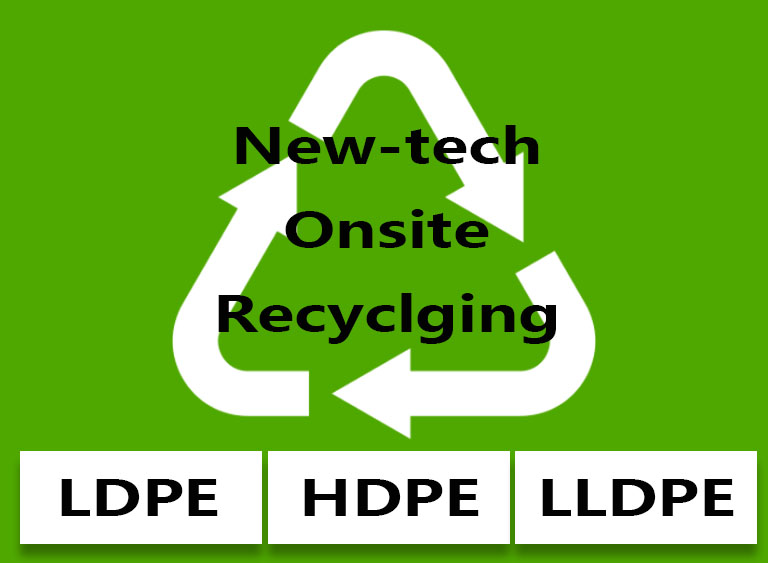Recycling is a crucial part of sustainable waste management, and polyethylene (PE) is one of the most commonly used plastics in the world. In this blog post, we’ll look at how to recycle LDPE, HDPE, and LLDPE scraps onsite.
Polyethylene (PE) Classification
Polyethylene is a thermoplastic polymer that is classified into three categories: Low-density polyethylene (LDPE), high-density polyethylene (HDPE), and linear low-density polyethylene (LLDPE). Each type has different physical and chemical properties, making them suitable for various applications.
Basic Information of LDPE
LDPE is a type of polyethylene with a density of less than 0.94 g/cm3. It is a flexible and transparent plastic that is often used in packaging films, grocery bags, and containers. LDPE is easy to process and has excellent resistance to water, acids, and bases.
Advantages of LDPE
- Flexibility: LDPE is a flexible plastic that can be easily shaped into various forms.
- Transparency: LDPE is transparent, making it ideal for packaging applications.
- Water resistance: LDPE is highly resistant to water and moisture, making it suitable for outdoor applications.
- Chemical resistance: LDPE has excellent resistance to acids and bases, making it useful in the chemical industry.
Disadvantages of LDPE
- Low melting point: LDPE has a low melting point, making it unsuitable for high-temperature applications.
- Vulnerable to UV rays: LDPE is susceptible to degradation from UV rays, which limits its outdoor use.
- Low tensile strength: LDPE has low tensile strength, making it unsuitable for structural applications.
Common Applications of LDPE
LDPE is used in various applications, including:
- Packaging films and bags
- Squeeze bottles
- Toys and playground equipment
- Agricultural films
- Corrugated pipes
Basic Information of HDPE
HDPE is a type of polyethylene with a density of more than 0.94 g/cm3. It is a stiff and strong plastic that is often used in pipes, containers, and toys. HDPE is easy to process and has excellent chemical resistance.
Advantages of HDPE
- Strength: HDPE is a strong plastic that can withstand high pressures and loads.
- Chemical resistance: HDPE has excellent resistance to chemicals, making it useful in the chemical industry.
- Weather resistance: HDPE is resistant to weathering and UV rays, making it suitable for outdoor applications.
- Recyclable: HDPE is easily recyclable, making it an environmentally friendly plastic.
Disadvantages of HDPE
- Low thermal resistance: HDPE has a low thermal resistance, making it unsuitable for high-temperature applications.
- Difficult to bond: HDPE is difficult to bond with other materials, making it challenging to use in multi-material products.
Common Applications of HDPE
HDPE is used in various applications, including:
- Water and gas pipes
- Bottles and containers
- Toys and playground equipment
- Chemical tanks
- Recycling bins
Basic Information of LLDPE
LLDPE is a type of polyethylene that is a blend of LDPE and HDPE. It has a density between 0.915 and 0.925 g/cm3, making it a more flexible and thinner plastic than HDPE. LLDPE is often used in packaging films, stretch wrap, and bags.
Advantages of LLDPE
- Flexibility: LLDPE is a flexible plastic that can be easily shaped into various forms.
- Strength: LDPE is a strong plastic that can withstand punctures and tears.
- Good cling: LLDPE has good cling properties, making it useful for stretch wrap applications.
- Resistance to punctures and tears: LLDPE has good resistance to punctures and tears, making it useful for packaging applications.
Disadvantages of LLDPE
- Lower chemical resistance: LLDPE has lower chemical resistance than HDPE, making it less suitable for some chemical applications.
- Limited thermal stability: LLDPE has limited thermal stability, making it unsuitable for high-temperature applications.
Common Applications of LLDPE
LLDPE is used in various applications, including:
- Stretch wrap
- Bags and packaging films
- Agricultural films
- Cable insulation
Comparison of LDPE, HDPE, and LLDPE
Here’s a comparison of the three types of polyethylene:
| Property | LDPE | HDPE | LLDPE |
| Density (g/cm3) | <0.94 | >0.94 | 0.915-0.925 |
| Flexibility | Highly flexible | Stiff | Flexible |
| Tensile strength | Low | High | Moderate |
| Chemical resistance | Good | Excellent | Lower than HDPE |
| Weather resistance | Vulnerable to UV rays | Resistant to weathering and UV rays | Moderate resistance to weathering and UV rays |
| Recyclability | Easily recyclable | Easily recyclable | Easily recyclable |
How to Recycle LDPE, HDPE, and LLDPE Scraps Onsite
The traditional way(not eco-friendly)
Recycling LDPE, HDPE, and LLDPE scraps onsite is a straightforward process that involves the following steps:
- Collect the scraps: Collect all the LDPE, HDPE, and LLDPE scraps generated onsite and sort them by type.
- Wash the scraps: Wash the scraps to remove any dirt, dust, or other contaminants.
- Shred the scraps: Shred the clean scraps into small pieces using a shredder.
- Melt the scraps: Melt the shredded scraps in a melting machine or extruder.
- Form the recycled material: Form the melted material into a new product using a molding machine or extruder.
The NEW way(Eco-friendly way to recycle onsite)
With a new-tech plastic granulator, Recycling polyethylene scraps onsite become an eco-friendly and cost-effective way to reduce waste and save resources for plastic film products manufacturers. The machine used is called new-tech plastic granulator, not like a traditional plastic granulator production lines, the new-tech plastic granulator adopts low-temp granualting technology, help to keep the original properties of the plastic materials, the process needs no water to cool, no aggressive high-temperature damage, no waste generated, no water pollution made. The new-tech plastic granualtor simple the recycling process as below:
- Put the scraps into the feeder;
- The screw will crush and half-melt the pieces and extrude them into short plastic strands;
- Just as the strands come out, the spinning blade will cut them into uniform pellets;
- The pellets will be air-cooled and blowed to the conveyor pipe to further cooling down.
Comparison the traditional plastic granulator and the new-tech plastic granulator
| Aspect | Traditional Granulator | New-Tech Granulator |
| Production Line Size | Large | Compact |
| Melting Technology | High-Temperature | Low-Temperature |
| Method of Melting | Direct Heat | Friction Heat |
| Impact on Plastic Properties | Changes properties of plastic | Maintains properties of plastic |
| Quality of Pellets | Lower quality pellets | Higher quality pellets |
| Reusability of Pellets | Fewer reusable pellets | More reusable pellets |
| Ease of Use | Requires experienced worker | Simple to operate with only a few buttons to click |
| Application Scenery | Suitable for general recycling centers that buy all kinds of plastic materials | Suitable for specific plastic product manufacturers to recycle scraps and unqualified products onsite. |
| Requirements of Recycled Materials | Materials need to be sorted, washed, and shredded by heavy labor, which is time-consuming and costly. | Materials do not need to be sorted or washed, and potential impurities can be filtered out by the mechanism, resulting in a lower cost and less time-consuming process. |
In summary, the traditional granulator requires recycled materials to be sorted, washed, and shredded, which is a time-consuming and labor-intensive process. In contrast, the new-tech granulator does not require any sorting or washing of recycled materials, and potential impurities can be filtered out by the mechanism. This results in a more efficient and cost-effective process for recycling plastic materials.
By recycling LDPE, HDPE, and LLDPE scraps in the new-tech way, you can not only save a big investment on traditional plastic granulator lines, but make the recycling process efficient and easy.
Conclusion
Polyethylene is a versatile plastic that is used in various applications worldwide. LDPE, HDPE, and LLDPE are three types of polyethylene with different properties and applications. Using a new-tech way of recycling polyethylene scraps onsite is an effective way to reduce waste and conserve resources.

